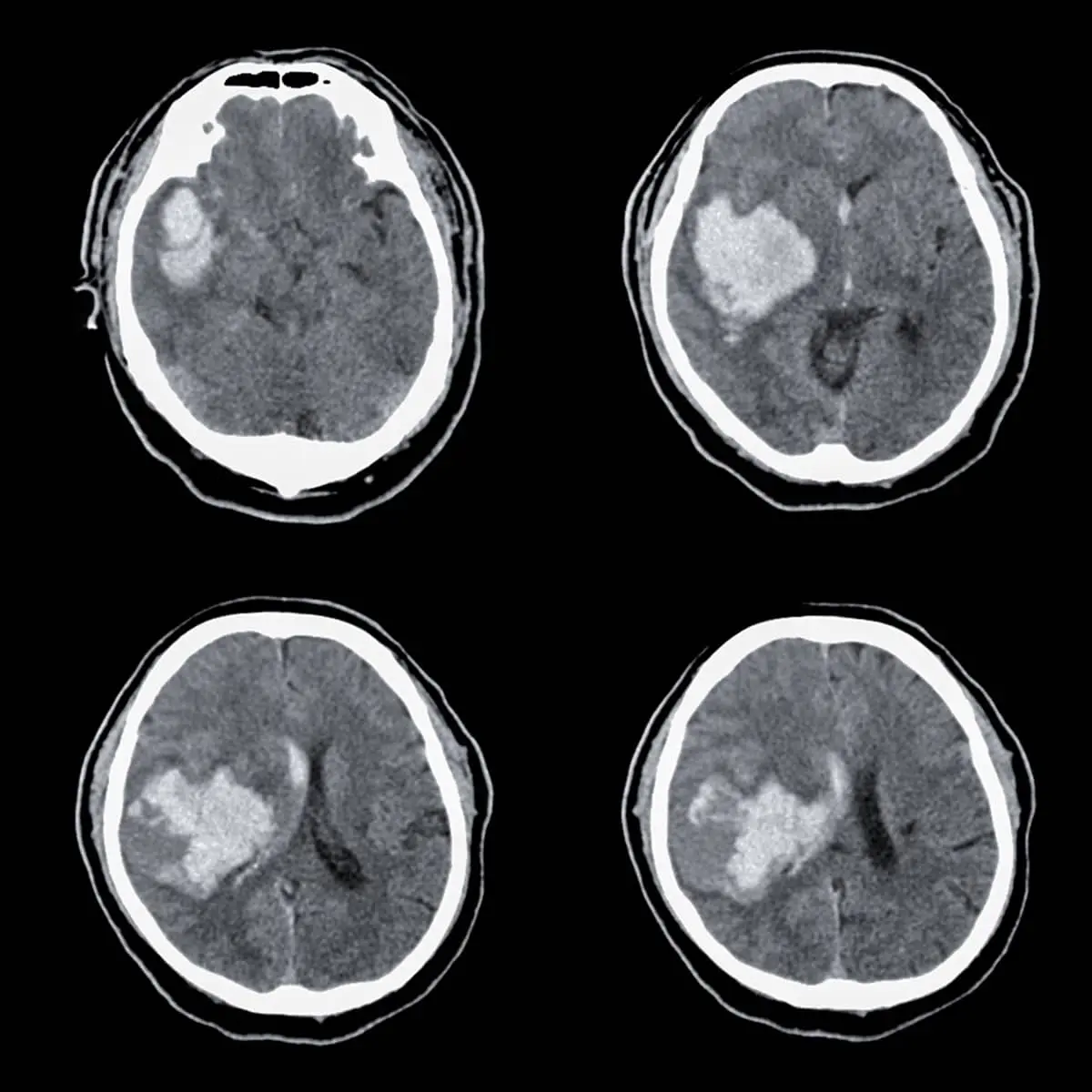Brain Hemorrhage
On this page, I will try to tell you the details about the symptoms and types of brain hemorrhage, diagnostic methods, brain hemorrhage surgery and its aftermath.I wish you all healthy days.
What is a Brain Hemorrhage?
Bleeding can occur in three separate anatomical regions within the skull.The first of these is brain tissue, the second is brain cavities, and the last is the brain surface.Brain hemorrhages can cause serious disability or death.

What Causes Brain Hemorrhage ? Who is at Risk?
Among the most important causes are head injuries, high blood pressure, aneurysm, blood vessel anomalies, amyloid angiopathy, bleeding disorders and brain tumors.
What are the Types of Brain Hemorrhage?
Intracerebral Hemorrhage
Intracerebral hemorrhage is a type of hemorrhage that is inside the brain tissue.Basic mechanism of formation; As a result of the rupture in the walls of small vessels in certain areas of the brain, blood leaks into the brain tissue and symptoms occur as a result of damage to this tissue.Blood thinners used for therapeutic purposes can also cause these types of symptoms.Important risk factors for intracerebral hemorrhage are hypertension, amyloid angiopathy, trauma, heavy alcohol use, and nicotine.In diseases such as hypertension and amyloid angiopathy due to the wear of the cerebral vascular structure due to advanced age and the loss of elastic properties, the vessel walls that have lost their normal properties are torn and the blood leaks into the brain tissue and accumulates.When the accumulated blood rises above a certain amount, it creates a mass effect in the brain, causing the functions of the relevant part of the brain to deteriorate and symptoms to appear.
Subarachnoid Hemorrhage
The most important cause of this type of bleeding is trauma. It can also be seen as a result of rupture of the vessels in the brain after the expansion in the form of bubbles or as a result of bleeding from the ball of vessels called arteriovenous malformation.Sometimes it can also occur in older people who are taking blood thinners because of a heart disease.Since the symptoms of a brain hemorrhage develop very suddenly and the pain is very severe, this pain is usually described by patients as the most severe headache in their lives.
Epidural Hemorrhage
Trauma is also one of the important causes in this type of bleeding.Epidural bleeding occurs when the bone called temporal bone on the side of the skull is broken for a traumatic reason and the vessel under this bone ruptures.Symptoms of cerebral hemorrhage in patients often develop rapidly and loss of consciousness occurs.Afterwards, this loss of consciousness is partially or completely opened and then closed again.It is a type of bleeding that requires urgent intervention.
Subdural Hemorrhage
The most important cause of subdural hemorrhages is the rupture or rupture of the veins that bridge the cerebral membrane and the brain and the leakage of blood to the outside.Since the veins here are veins, the intravascular pressure is low and the appearance of bleeding is often slow.As a result of these bleedings, the appearance of symptoms can sometimes take up to 2-3 weeks.
What are the Symptoms of Brain Hemorrhage?
Symptoms may vary from person to person. In addition, according to the severity of the bleeding and the amount of tissue affected, the severity of the symptoms may vary.The symptoms that arise may develop suddenly or over time, or the resulting bleeding may progress further over time, causing the patient to worsen.Symptoms of cerebral hemorrhage are severe headache, nausea and vomiting, dizziness, epilepsy attack called sara among the people, disturbance of consciousness ranging from mild clouding of consciousness to coma, and disorders in brain functions due to the brain region where the bleeding occurs.

Brain Hemorrhage Surgery
Brain hemorrhage surgery is performed with 2 basic methods. The first of these is open brain surgery, and the other is the operation performed by endovascular method, which is called closed brain hemorrhage surgery by the public.The most preferred method of surgical treatment of brain hemorrhages is open brain surgery.Patients are taken to the operation with general anesthesia, the hair in the area to be operated is cut and local anesthesia is applied to the area to be operated.This also ensures that the bleeding after the incision applied to the scalp, which has a very bleeding structure, is also low.After the skin incision is applied, the scalp on the head is opened, and then holes are made in the skull bone to remove the part of the skull bone that fits the bleeding site.Then these holes are again combined with the help of a high-speed knife that cutters the bone and the skull bone is removed.The structure that comes to us later is the membrane layer called dura, which completely surrounds the brain.
After this membrane layer is cut and opened, the brain tissue comes to us and the bleeding area is reached by advancing appropriately between the brain cavities or brain folds and the bleeding is stopped by intervening in the vessels here.
In addition, the blood clot that presses on the brain, which we call the hematoma formed here, is removed and the pressure on the brain tissue is removed.After making sure that the bleeding does not continue in this area, the membrane layer called dura is sutured, and if necessary, a special substance called tissue adhesive is squeezed on it to prevent the leakage of cerebrospinal fluid.Then, at the beginning of the surgery, the bone we cut is placed in the tissue place and determined by connecting to the other skull bone in the vicinity with the help of titanium small plaques.
In the bleeding due to aneurysm, which is called bubble in the brain among the people, or in the vascular diseases of the brain, which is called arteriovenous malformation called vascular ball but in medicine, sudden brain hemorrhage symptoms and very serious problems related to these hemorrhages may occur, and even patients may be lost.With the closed surgery method, which we call endovascular method, which has developed in recent years, it is possible to reach and intervene in these vessels.
After the brain hemorrhage surgery is over, the process of waking the patient from anesthesia begins.Sometimes, patients are taken to intensive care without being woken up, that is, intubated.During the intensive care period, the nutritional needs of the patients are met by looking at the general health status and special drug treatments that will reduce brain pressure and reduce brain edema are given.All vital functions of the patient are monitored very closely.Patients are checked by taking computed brain tomography at regular intervals.Patients who are not intubated after brain hemorrhage surgery can be taken to their normal rooms after a short intensive care period of 1 day.Brain hemorrhage surgery and its aftermath is a very severe clinical process and patients are generally prone to immunity in this process, and the risk of infection is slightly higher in this patient group.For this reason, visitors should not be taken with these patients.
Patients who have undergone brain hemorrhage surgery, which is not problematic during the monitoring phase in the normal room, can be discharged after the last time computed brain tomography is taken for control purposes.The most common question asked by patients is about how long to return to normal life after such an operation.Patients who have not developed a loss of strength after surgery can return to their normal routine life in a period of 2-3 months.After the operation, complaints such as burning, stinging and pain may occur at the incision site.If these complaints become continuous, the patient will need to see a neurosurgeon.Patients should be monitored in the postoperative period so that their blood pressure is kept within the normal range.Because these patients are prone to bleeding again from the area where they have undergone surgery.For this reason, the symptoms of brain hemorrhage should be explained in detail to the patients without discharge and it should be emphasized that they should urgently reach the hospital in the presence of any of them.
Brain hemorrhage surgeries are very risky and have the possibility of losing the patient to death.In particular, the late recognition of the symptoms of brain hemorrhage and the late surgical intervention of the patient is the most important factor that increases the risk of death.Brain tissue infarction caused by the intense pressure exerted on the brain by the blood accumulated during this period and the inadequate nutrition of the areas fed by the bleeding vessel or vessels in the brain is the most important cause of the risk of permanent disorders and / or death in patients.Another important reason that increases the risk of death is advanced age and pre-existing systemic diseases in the patient.
What to Do After a Brain Hemorrhage
Patients who have undergone brain hemorrhage surgery should make certain adjustments in their lives after discharge.These include brain and neurosurgery or neurologist examination at regular intervals, follow-up of the treatment given to keep blood pressure measurement values within normal limits, proper follow-up of the drug doses of patients taking blood thinners, quitting smoking and alcohol habit, making a life plan away from tension or as low as stress as possible, and an exercise program to be planned with professional support.In addition, since older people are more vulnerable to trauma, it is very important to take measures that will reduce the likelihood of head trauma.
Among the factors that reduce the likelihood of bleeding in trauma-related brain hemorrhages are the seat belts of the people in the vehicle, and the use of helmets by the people who use the vehicle such as motorcycles or bicycles.The presence of permanent or temporary damages after brain hemorrhage surgery reveals the need for rehabilitation in patients.If patients have partial paralysis, regular physical therapy and rehabilitation provide great support to recovery in patients.Rehabilitation contributes to meeting the patient's daily requirements and regaining normal or near-normal functions of the problem area, especially in patients with partial paralysis.
Again, it is necessary to pay special attention to nutrition in patients during and after the recovery period.A diet with a predominance of white meat should be chosen, avoiding red meat.In addition, patients should not eat salt and sugary foods, should consume plenty of water, and should be fed with a Mediterranean diet based on fruits and vegetables.Another important issue is that patients should avoid smoking and alcohol use after brain hemorrhage surgery.If patients after brain hemorrhage have speech impairment, loss of strength in the arms or legs and/or coordination disorders, rehabilitation programs for these problems should also be planned.
